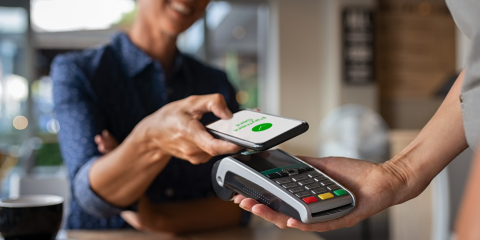Best Practices for Credit Card Transactions
11/15/2023
By: Fidelity Bank

While card payments offer convenience and efficiency, businesses must remain vigilant and proactive to ensure that every transaction is secure and legitimate.
Don’t shy away from contactless payments. Card encryption creates a unique verification code for each use, making stolen data obsolete.
Accepting credit cards can help your business grow. Learn how to avoid payment hurdles and boost trust.
In today’s business landscape, simplicity rules. With about 70% of Americans wielding credit cards, embracing card payments isn’t just smart – it’s strategic. But, of course, where there’s opportunity, challenges follow. Payment fraud and chargebacks can be headaches, draining your time and resources. But don’t worry – by taking precautions, you can dodge these hurdles.
When you accept a credit card payment, you and your customer enter an unwritten pact: your goods for their payment. But agreements can go astray. The good news? You can reduce the odds of disputes and fraud with a few easy-to-follow actions.
In this article, we’ll look at both card-present and card-not-present transactions and outline best practices for each.
Card-Present Transactions
Card-present transactions refer to scenarios where the customer is physically present with their card at the point of sale. This could be in a retail store, at an event, or anywhere the cardholder uses their card to make a purchase.
- Tap or Insert EMV Cards
Modern credit and debit cards come equipped with EMV (Europay, Mastercard, and Visa) chip technology. Businesses should use terminals that support this technology because it adds an extra layer of security. Remember to prompt customers to either tap their card or insert it to access the chip rather than use the outdated swipe method.
- Confirm the Customer’s ID
To ensure that the person using the card is the legitimate cardholder, it’s a good habit to ask for a photo ID, especially for larger transactions. This simple step can help in preventing unauthorized or fraudulent purchases.
- Confirm the Transaction Amount
Before processing the payment, always confirm the final amount of the purchase before the card is charged. This helps prevent accidental overcharges and ensures that the customer is aware of the exact amount being charged.
- Provide the Receipt
Once the transaction is complete, always provide the customer with a receipt, whether printed or electronic. It’s not only professional but also offers a record of the transaction for both you and the customer.
Card-Not-Present Transactions
Card-not-present transactions are becoming increasingly popular with the rise of online shopping, phone orders, and subscription services. As the name suggests, these transactions happen when the cardholder is not physically present with the card.
- Get the Details Correct
This might sound elementary, but make sure you double-check the card details entered, be it the card number, expiry date, or card verification value (CVV). Incorrect details can lead to transaction failures, negatively impacting your conversion rates.
- Get Delivery Confirmation and/or Proof of Service
For businesses that ship products or provide services, obtaining a delivery confirmation or proof of service provides a record that the customer received the product or service, protecting you against potential disputes.
- Confirm the Billing and ZIP Codes
Always confirm the billing address and ZIP code associated with the card. This is an added layer of verification that the person making the purchase has knowledge of the card’s associated details, further reducing the risk of fraud.
- Obtain Approvals on Recurring Payments
If your business involves recurring payments, such as subscriptions, always ensure you have the customer’s explicit permission to charge their card. Keep records of these approvals to protect against any future disputes or chargebacks.
Protect Against Disputes and Fraud
Follow these practices for all card transactions:
- Clear refund policies. Be upfront about your refund policy. If you don’t offer refunds, it should be clearly stated on receipts and in any store or online locations. But if you allow refunds, always direct them back to the original card. For in-person transactions, getting a signed acknowledgment will help ensure that everything’s above board.
- Easy-to-find contact info. Put your contact details – like phone number, email, and address – on the receipts. It makes it so much easier for customers to get in touch if they’ve got questions regarding a transaction. Be sure that the name on your receipt mirrors what appears on the customer’s statement. If there’s a discrepancy, it’s helpful to inform customers what name they’ll see on their statements; it clears up potential confusion.
- Complete transactions by day’s end and separate employee purchases. Finalize all transactions at the close of each day so that any issues can be identified and resolved swiftly. Additionally, employees should not handle their own card transactions. This practice maintains transparency and reduces potential conflicts.
- Uphold PCI standards. Staying compliant with PCI standards isn’t just a formality, it’s essential. It safeguards both your business and your customers from potential pitfalls.
Move Forward
While card payments offer convenience and efficiency, businesses must remain vigilant and proactive to ensure that every transaction is secure and legitimate. By following these best practices, you can ensure a smoother transaction process, enhance customer trust, and protect your business from potential pitfalls.
For more information about handling credit card transactions and managing business finances, contact your Fidelity Banker today.
